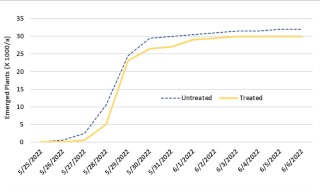By Anthony Bly
Written collaboratively by Anthony Bly, SDSU Extension Soils Field Specialist, Austin Carlson, South Dakota Soil Health Coalition Technician, and Baylee Carlson, USDA/NRCS Conservationist.
Many corn producers have interest in knowing the effects of omitting corn seed treatments on plant stands, microbial activity and grain yield. A small field scale evaluation was conducted on a farmer’s field that was included in the 2022 South Dakota Soil Health Coalition’s Soil Health School.
Soil Health School Field Evaluation
METHODS USED
One hybrid, with and without seed treatment, was planted on May 14, 2022 at 32,500 seeds per acre in random 6 to 30 inch row strips across a field. Plot lengths varied from 950 to 1050 feet. Seedling plant emergence counts were obtained from predetermined small plots near the west end of the field strips. Early-season climatic temperatures were lower than normal, and seedlings took longer than usual to emerge from the soil.
FINDINGS

The first corn seedlings to emerge came on May 5, 2022, 12 days after planting. Seed treatment did not cause corn seedlings to emerge more quickly compared to seeds without treatment. The opposite effect is shown on Figure 1. Corn seeds with no seed treatment had advanced emergence compared to those with seed treatment. Final stands are slightly higher from seeds with no treatment at about 32,000 (plants per acre), while the stand from treated plots was 30,000 (plants per acre). The effects on soil microbiology show that untreated seed plots had higher CO2 respirations and microbial active carbon (Table 1). It is unknown if these difference have a significant impact on soil biology function and benefits and should be further investigated. Grain yield averages were not different between treatment plots with and without seed treatment.
Table 1. Corn seed treatment comparison, Soil Health School 2022, Garretson SD.
| Seed Treatment1 | CO2 burst2
ppm C | MAC3
% | Grain Yield4
bu/a |
|---|
| Yes | 137.7 | 128.8 | 217.1 |
| No | 154.6 | 155.3 | 217.5 |
Soil Organic Matter (LOI) for soil type at this site = 4.6%
- Seeds from same hybrid either treated or untreated, planted at same population (32,500) on May 14, 2022.
- Carbon Dioxide (CO2) captured from microbial activity after soil wetting.
- Microbial active carbon = % of water extractable carbon that is from microbial respiration.
- Grain yield average of 4 replications (randomized strips) at 15% moisture.
Source : sdstate.edu